The Joint Strike Super Fighter
Anchors aweigh: 100 years of naval aviation—A GA pilot’s perspective
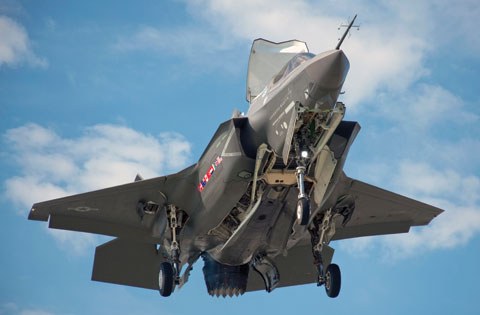
It has been 34 years since I flew a carrier approach, so I got a rock in the pit of my stomach when my tour guide at the Lockheed Martin plant in Fort Worth, Texas—retired U.S. Navy Capt. Craig Williams, an F/A–18 Hornet pilot and former air wing commander aboard the USS Ronald Reagan—suggested I fly one in the F–35 simulator. Crashing the sim wouldn’t do much for my ego or reputation, such as it is. Oh well.
“Sure,” I said blithely.
In just a few seconds I was there, approaching one of the Navy’s big gray flattops on a clear, sunlit day, on a wide, empty sea. “Damn small boat,” I muttered.
In the cockpit demonstrator, the flight data symbology that will be projected on the inside of the pilot’s helmet visor in the real airplane was projected on the screen that held the ship. There was the track line, the angle of attack symbol, the altitude and airspeed, the sink rate symbol….
I snapped the gear handle down and pushed the button to lower the tailhook. The weapons were safe. That was the entire landing checklist. Flaps and slats are automatically deployed as the airspeed bleeds off. This supersonic fighter-bomber is easier to fly than anything I ever sat in.
Now I started descending, slewing the airplane with rudder (“Probably better keep your feet flat on the deck,” Williams suggested diplomatically) and overcontrolling the airspeed, which should be 143 knots at max trap weight; lined up fairly well, looking for the ball. And by glory, there it was! Now too fast, now too slow—but coming down at about 600 feet per minute.
The ship got bigger and bigger, I got fast…and would have bolted but the sim, being forgiving, let me catch a wire.
“No grade eight-wire,” I told Williams, grinning like a fool.
Just visiting the mile-long Air Force Plant Number Four in Fort Worth is a treat in itself. Originally constructed to manufacture B–24s during World War II, the facility is a national treasure. B–36s were built here; B–58s; F–111s; F–16s; F–22s; and now F–35s, the fifth-generation fighter-bomber that will form the backbone of American tactical air power for the next 30 or so years. Or 60 years, if one Navy prognosis is to be believed.
The F–35 Lightning II is a single-pilot, fly-by-wire, glass cockpit, single-engine supersonic stealth fighter-bomber that carries up to 5,200 pounds of weapons in an internal bomb bay, and can carry additional weapons on external racks under the wings.
The F–35 began life 14 years ago as the Joint Strike Fighter. At a projected $323 billion, it is the most expensive weapons procurement program in history. It is also a huge technical challenge, since three different models of the same airframe are on the assembly line at the same time—three different models intended to perform three different missions. That’s a lot of design compromises, and I confess, I have been curious for years about the resulting aircraft. The last mixed Air Force/Navy fighter-bomber I recall was the F–111, McNamara’s TFX, a huge supersonic airplane that turned out to be too heavy to go aboard aircraft carriers.
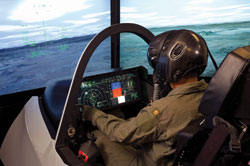 The JSF program has missed some deadlines; a weight problem was faced and addressed, carving 2,700 pounds out of all three variants. Engine manufacturers have squabbled over which engine should go in the thing. Defense experts of every stripe have weighed in repeatedly about everything from the limited bomb-bay capacity to the single-seat concept. Congresspeople have also weighed in; $323 billion is a big pie to cut up.
The JSF program has missed some deadlines; a weight problem was faced and addressed, carving 2,700 pounds out of all three variants. Engine manufacturers have squabbled over which engine should go in the thing. Defense experts of every stripe have weighed in repeatedly about everything from the limited bomb-bay capacity to the single-seat concept. Congresspeople have also weighed in; $323 billion is a big pie to cut up.
The F–35A Lightning II will be the backbone of many allied armed forces, such as the United Kingdom, Canada, Australia, Turkey, the Netherlands, Denmark, Italy, and Norway, all of which have signed contracts and most of which are making subassemblies. Manufacturing the F–35 is truly an international effort. Other nations interested in acquiring planes include Israel, Singapore, Spain, and Japan. Currently Lockheed Martin plans to make 1,763 F–35As, the Air Force version, and 680 F–35s for the Navy and Marine Corps. International partners will order another 800 to 1,500, Lockheed hopes, and if they do, the production rate will rise to more than 250 per year on a moving assembly line, with roughly one aircraft completed every working day.
Two 1,000-pound JDAM smart bombs and two advanced medium-range air-to-air missiles (AMRAAMs) would probably be a typical internal loadout. With a full bomb bay and full internal tanks, the plane can make Mach 1.6 at altitude, thanks largely to its huge engine, which produces 24,000 pounds of thrust at full military power and 40,000 pounds in afterburner. Very Low Observable (VLO) stealth characteristics are designed in, such as a reduced-signature tailpipe nozzle.
Will this airplane carry external weapons? Routinely, in low-threat environments. This flexibility gives mission planners a lot of options, which are desperately needed in the low-intensity wars we have been fighting on and off since Vietnam. Yet if called upon to fight in high-threat theaters, the airplanes’ capability must be there, not on back order.
Either of two engines will fit into any F–35 airframe, and they will be interchangeable: the Pratt & Whitney F135 and the GE/Rolls Royce F136. Performance from both engines is similar, and the pilot won’t be able to tell which one is installed. Unlike the F–22, this plane does not have vectored thrust, which keeps the price within the realm of reason. While it won’t be the world’s most maneuverable fighter, military officials believe the F–35 will be the world’s finest fighter-bomber, capable of delivering guided ordnance with pickle-barrel accuracy from any altitude, in any weather; shooting down enemy fighters; and getting down in the weeds to duel with tanks or shoot up technicals and Scud launchers.
The Air Force version, the F–35A, 51.4 feet long, has a wingspan of only 35 feet, and a wing area of 460 square feet. This variant carries 18,500 pounds of fuel and has a max-G hemorrhoid rating of 9.0. The airplane has an internal 25-mm gun mounted on the left shoulder.
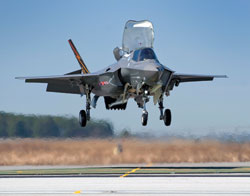 The F–35B, the Marine version, gives away 5,000 pounds of fuel to the A model in order to get short takeoff (700 feet) and vertical landing (STOVL) capability. The B model actually has a ducted fan mounted behind the cockpit that helps develop 40,000 pounds of vertical lift. Max G will be about 7.0. This airplane will replace the Marines’ Harriers and F/A–18s.
The F–35B, the Marine version, gives away 5,000 pounds of fuel to the A model in order to get short takeoff (700 feet) and vertical landing (STOVL) capability. The B model actually has a ducted fan mounted behind the cockpit that helps develop 40,000 pounds of vertical lift. Max G will be about 7.0. This airplane will replace the Marines’ Harriers and F/A–18s.
The Navy version, the F–35C, is also 51.5 feet long, with a dual nose tire, catapult nose-tow gear, a real tailhook—and it has more wing, 668 square feet, so it can fly slower carrier approaches and carry more fuel: 20,000 pounds in internal tanks. The designers added four feet of wing to each side, and built a wing-fold mechanism to reduce the airplane’s footprint aboard ship. The G rating is 7.5. The extra fuel gives this beauty an unrefueled combat radius of 600-plus nautical miles, just the reach F/A–18 Hornets and Super Hornets lacked. In addition, it can bring back 10,000 pounds of ordnance and fuel in an arrested landing, so dumping valuable weapons into the ocean won’t be necessary. Unless it is carrying a full load of internal and external weapons, the C will take the cat shot in military power, a huge savings in fuel. (If the pilot wants afterburner for the shot, computers will limit the burner output—and its appetite for fuel—until the plane reaches flying speed at the end of the cat stroke, when the extra thrust will actually be needed: Then the pilot will have the full 40,000 pounds of push.)
Engine and airframe get you and your weapons to the fight, but the computers and sensors in the airplane give the pilot the ability to survive in a high-threat environment, accurately hit his or her target or shoot down enemy fighters, and get back to base to do it again. The airplane features a seamless mix of sensors: radar, an infrared sensor and laser designator in a faired chin turret, and electronic countermeasures (ECM) and infrared sensors buried in the skin all over the airplane. The Northrop Grumman radar is a fixed-phase, electronically scanned array with no moving parts—one designed to last as long as the airframe, 8,000 hours, without maintenance. In fact, the airplane’s nose cone is bolted on, so access to the radar is neither easy nor routine.
Computers? F–35 software features 5.9 million lines of code. Lockheed Martin built the core processor, which churns through more than 1 trillion operations per second. In contrast, the F–22 needed a little over 2 million lines to make it perform. Phase Three F–35s may well have over 8 million lines of code.
The radar picture looks like something from science fiction. Forget those old WWII and Vietnam-era radar presentations that depicted blips of return that the operator had to interpret. The ground return presentation looks precisely like a satellite photo, and it is so detailed that I could see cracks in an old runway. Add in the data from the infrared and ECM, seamlessly integrated in a process Lockheed Martin calls fusion, and I could see the fading heat planform shadow of a recently departed airplane on the parking ramp.
System data is shared between flight members with a multifunction advanced datalink system that uses a new generation of transmission technology to maintain stealth. A standard Link 16 system is also incorporated to send the F-35s’ information to legacy aircraft or ground units. What one airplane detects, all pilots in the flight see.
The F–35 has no head-up display, freeing designers from the HUD’s inherent angular limitations. Instead, information in the form of symbols and numbers are presented on the inside of the flight helmet visor. By merely turning his or her head, the pilot can see the fused tactical situation to the right, left, rear, up or down. Want to know what’s under you or below the canopy rail? Don’t roll the airplane and look; merely tilt your head to see right through the cockpit floor or sides.
Lockheed Martin has carried the hands-on-stick-and-throttle concept to its logical conclusion. Both the side-mounted stick and massive power lever are festooned with buttons, switches, and mouse controllers. I’ve seen fewer controls on a saxophone. Still, with training and practice in the simulator, F–35 pilots will not even have to think about which control to operate; it will become automatic, like typing or playing a piano.
The only conventional switches in the cockpit are used to start the engine. There are no arrays of circuit breakers or fuses; no buttons, toggles, or twisties, except on the stick and throttle handle. There are, however, two glaring exceptions: the conventional landing-gear control handle looks as if it came out of a Bonanza, yet it merely operates a microswitch. Its presence was a concession to pilots, who demanded it. There is something reassuring about a handle, which is either down or up. And on the left side of the panel, up and out of the way of the glass computer presentations, is one conventional pushbutton. In the A and C models it lowers the tailhook. On the B model, pushing the button allows the transition to a vertical landing, when certain parameters are met.
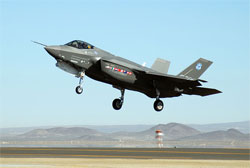 What is Fifth Generation? VLO stealth, state-of-the-art fighter performance, integrated information and sensor fusion, net-enabled operations, unparalleled range and persistence, and designed for unsurpassed sustainability (maintainability) and deployability.
What is Fifth Generation? VLO stealth, state-of-the-art fighter performance, integrated information and sensor fusion, net-enabled operations, unparalleled range and persistence, and designed for unsurpassed sustainability (maintainability) and deployability.
So how much does one cost? Eyes glaze over when that question is asked, since so much of the cost is fixed and unit costs hinge on production rates, which depend on future defense budgets and unpredictable political factors. So far, the folks at Lockheed Martin told me, the program is 15 to 20 percent below original cost estimates, which is a triumph of the first order of magnitude for a program of this scale, with subassemblies manufactured all over the world. “We learned a lot from Boeing’s experience with the Dreamliner,” one engineer told me. The numbers quoted go like this: F–35A, $60 million plus; F–35C, mid-$70 millions; F–35B, $80 million to $85 million.
America’s armed forces are facing a much-talked-about “fighter gap.” In truth, the F–16s, F/A 18s, and Harriers, which the F–35 will replace, are wearing out. The Joint Strike Fighter program was intended all along to address that reality. The risks were huge: three airplanes, one common airframe? It must be maintainable, survivable, and have a state-of-the-art system installed that allows the pilot to win the fight. And, of course, we don’t want to pay a single penny more than necessary to get it.
The F–35 is that airplane. It will have the most sophisticated all-weather air-to-ground and air-to-air system in the world when it becomes operational, and it will have extraordinarily long legs. In my opinion, this is not just an airplane the armed services need; it is an airplane they must have to maintain air supremacy during the first half of the twenty-first century. In the years ahead it will probably receive the usual service life extension programs that will keep the airframe operational and update the various systems to state of the art.
I walked around an F–35A sitting in a hangar and oohed and aahed. Our next generation of fighter pilots is going to have a super weapon to fly. If only I were 22 again and just starting pilot training….
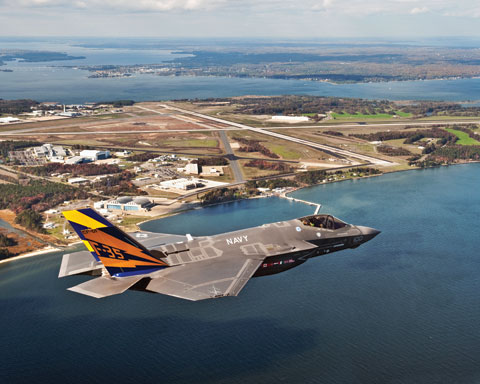
Novelist Stephen Coonts’ latest book is The Disciple . He flew A–6 Intruders from USS Enterprise during the Vietnam War.


